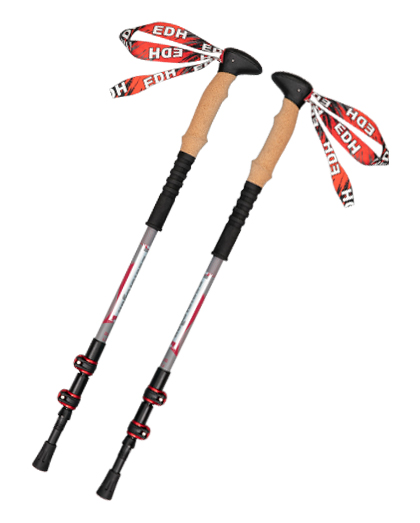

Hiking poles, also known as trekking poles or climbing sticks are essential hiking accessories which are designed for safe hiking in rough terrain and high altitudes. They are strong and durable, and serve to protect the user from the perils of bad weather and unpredictable hiking trails. In addition, they are strong enough to carry the weight of the user and his equipment. It is difficult to imagine a hiker without hiking poles, because these accessories make hiking into an enjoyable, if not thrilling, experience.
Hiking poles have been in use since ancient times, where they were used as tools for trekking and for climbing cliffs and other obstacles found in the wilds of the world. Hiking poles have many types, and models are manufactured depending on the purpose for which they will be used. There are two types of hiking poles available in the market today, namely, mechanical and automatic. Manual hiking poles are generally used by hikers and mountaineers, who want more control over their movement and the direction of their trek. Manual hiking poles have a hinge from where one can draw the upper rope to tighten, thus enabling the user to regulate the tension.
An automatic hiking pole consists of two parts; the first part is a spring loaded brake, which can be engaged by a simple push of a button, and the second part are a cleat with which the user may choose the level of friction. These trekking poles have a locking mechanism, which enables them to stay fixed in the place. The locking mechanism of these trekking poles works on the principle of a lever- operated valve and uses either a key or a combination of a key and a locking mechanism. Manual hiking poles do not offer any such flexibility. When the user wants to adjust the tension of the rope he needs to cut the locking mechanism off, remove the spring and reset the valve. It is possible to determine the type of locking mechanism in a manual hiking pole by observing the presence of a screw drive on either side of the pole.
The third type of hiking poles available are those used by cross country skiers and hunters. They are much heavier than the other two and cannot be used by hikers without poles. These trekking poles differ from the automatic ones in a way that they feature a wire frame which enables them to hang without the use of ropes or other materials. In this way, they enable users to take their equipment along for the trip. Cross country skiers use these poles in a similar manner as the hiking poles. They simply leave the pole on the ground and keep it there until they are ready to move.
Some people prefer lightweight trekking poles, especially for carrying on short trips, where having the required strength isn't a must. This is why some manufacturers have come up with lightweight poles with detachable ankle-carrying handles. Such a pole will come with a rubber wrist strap and a zippered pocket in which to put all the necessary objects. Since these trekking poles don't need any ropes or other materials to carry, they can be carried on the user's back, in a similar way as a backpack.
Hiking poles which feature locking mechanisms are very popular among hikers. There are two types of locking mechanisms: external locking mechanisms which are fixed onto the pole's underside and internal ones which are embedded in the pole. External locking mechanisms ensure that only a single object can occupy the same space as the pole. On the other hand, internal ones allow more objects to hang down, but they are less secure. Users who intend to go trekking in a group should invest in external locking mechanisms. This is because it is more difficult for an inexperienced hiker to open a locked hiking pole.
